November 8, 1895
One hundred and twenty nine years of X-rays…

Well, technically they’ve always existed. But their discovery dates back to an auspicious autumn night in 1895, when a certain Wilhelm Conrad Röntgen (1845-1923), chair of physics at an unassuming Bavarian town named Würzburg, noted an unusual phenomenon.
So how did it all come to be? What business did Röntgen have messing around with barium platinocyanide and glass tubes? On the anniversary of this enormous discovery, a summary for the modern day clinician (and a brush-up on physics).
Preamble
The late nineteenth century was an exciting time in the field of science and physics, with fervent experimentations developing our understanding of electromagnetics at breakneck speed.
Röntgens famous discovery appears to have been a side track of his experimentation with cathode rays, which in the late 19th century, had drawn the fascination of all the prominent scientists of the time. Heinrich Hertz (1857-1894), who in 1888 discovered radiowaves, had also demonstrated that these cathode rays had an ability to penetrate a very thin sheet of metal foil, placed inside the tube wherein they were generated.
Hertz’s student, Philipp Lenard (1862-1947) then developed a tube with an aluminium window at the end, which would theoretically allow the cathode rays to exit the glass tube to which they had been confined in previous designs by physicists Hittorf and Crookes. Lenard was successful, and in 1894 published his finding, that cathode rays could have a photographic effect on a plate coated in keton (pentadecylparatolylketone) up to 8cm away.


Cathode rays to travel outside the glass container
News of Lenard’s research had reached the ears of Röntgen, who was 17 years his senior, an internationally renowned scientist already at this point, and on the cusp of being appointed rector of the university of Würzburg. Eager to reproduce this experiment, Röntgen exchanged letters with Lenard, a budding young physicist, who in turn helped him acquire a Lenard style tube of his own, straight from the manufacturer in May 1894.
Letters from Röntgens collection show that in July of that year, an order for keton was sent to him from a chemist in Heidelberg, which effectively leaves a window of a few months, that is the key to understanding the role of barium platinocyanide in our story.
Barium platinocyanide was known to scientists at the time to have fluorescent properties in ultraviolet light, so it is likely that Röntgen reached for this medium in his initial experiments with the Lenard tube, whilst he waited for his delivery of keton. His work was however interrupted with his appointment to rectorship, and it wasn’t until autumn of the following year, that he was able to explore his curiosity for cathode rays further.
Friday, 8th November 1895
Friday evenings are a good time for the professor to delve into his research, as he is unlikely to be disturbed by students or coworkers. Röntgen is working in his laboratory, tinkering with Lenard and Crookes’ style tubes of cathode rays, and using different materials (cardboard and zinc) to encase the tubes, curious as to whether a fluorescent effect can be reproduced.
What happened next, is best summed up in Röntgen’s own words during a fascinating interview with H.J.W. Dam of the New York-based McClure’s Magazine in April 1896:
“I was working with a Crookes tube covered by a shield of black cardboard. A piece of barium platino-cyanide paper lay on the bench there. I had been passing a current through the tube, and I noticed a peculiar black line across the paper.”
“What of that?”
“The effect was one which could only be produced, in ordinary parlance, by the passage of light. No light could come from the tube, because the shield which covered it was impervious to any light known, even that of the electric arc.”
“And what did you think?”
“I didn’t think; I investigated.”
“I assumed that the effect must have come from the tube, since its character indicated that it could come from nowhere else. I tested it. In a few minutes there was no doubt about it. Rays were coming from the tube which had a luminescent effect upon the paper. I tried it successfully at greater and greater distances, even at two metres. It seemed at first a new kind of invisible light. It was clearly something new, something unrecorded.”
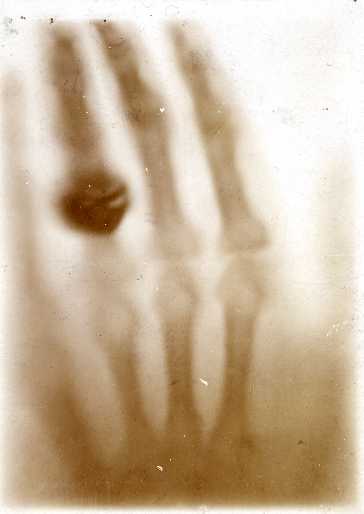
Naturally startled by the nature of his discovery, Röntgen delved into deep experimentation for the following weeks, speaking to no-one of his findings, and spending all his time shut in the laboratory. He found that the penetrance of these new rays could be captured on a photographic screen, and initially took pictures of metal disks and coins inside a purse.
Then, the most iconic moment of all, when he exposed the hand of his wife Bertha under the new-found rays for 15 minutes, producing the picture known as “Hand mit Ringen”
Aftermath
The enormity of the discovery and the global impact on medicine is best recounted by H.J.W. Dam writing just four weeks after the announcement.
In all the history of scientific discovery there has never been, perhaps so general, rapid, and dramatic an effect wrought on the scientific centres of Europe as has followed, in the last four weeks, upon an announcement made to the Würzburg Physico-Medical Society, at their December 1895 meeting, by Professor William Konrad Röntgen, professor of physics at the Royal University of Würzburg. The first news of which reached London was by telegraph from Vienna to the effect that a Professor Röntgen, until then the possessor of only a local fame in the town mentioned, had I discovered a new kind of light, which penetrated and photographed through everything. This news was received with a mild interest, some amusement, and much incredulity; and a week passed. Then, by mail and telegraph, came daily clear indications of the stir which the discovery was making in all the great line of universities between Vienna and Berlin. Then Röntgen‘s own report arrived, so cool, so business-like, and so truly scientific in character, that it left no doubt either of the truth or of the great importance of the preceding reports.
To-day, four weeks after the announcement, Rontgen’s name is apparently in every scientific publication issued this week in Europe; and accounts of his experiments, of the experiments of others following his method, and of theories as to the strange new force which he has been the first to observe, fill pages of every scientific journal that comes to hand. And before the necessary time elapses for this article to attain publication in America, it is in all ways probable that the laboratories and lecture-rooms of the United States will also be giving full evidence of this contagious arousal of interest over a discovery so strange that its importance cannot yet be measured, its utility be even prophesied, or its ultimate effect upon long-established scientific beliefs be even vaguely foretold.
Unlike most epoch-making results from laboratories, this discovery is one which, to a very unusual degree, is within the grasp of the popular and non-technical imagination. Among the other kinds of matter which these rays penetrate with ease is the human flesh. That a new photography has suddenly arisen which can photograph the bones, and, before long, the organs of the human body; that a light has been found which can penetrate, so as to make a photographic record, through everything from a purse or a pocket to the walls of a room or a house, is news which cannot fail to startle everybody.


That the eye of the physician or surgeon, long baffled by the skin, and vainly seeking to penetrate the unfortunate darkness of the human body, is now to be supplemented by a camera, making all the parts of the human body as visible, in a way, as the exterior, appears certainly to be a greater blessing to humanity than even the Listerian antiseptic system of surgery; and its benefits must inevitably be greater than those conferred by Lister, great as the latter have been.
Already, in the few weeks since Röntgen’s announcement, the results of surgical operations under the new system are growing voluminous. In Berlin, not only new bone fractures are being immediately photographed, but joined fractures, as well, in order to examine the results of recent surgical work. In Vienna, imbedded bullets are being photographed, instead of being probed for, and extracted with comparative ease. In London, a wounded sailor, completely paralyzed, whose injury was a mystery, has been saved by the photographing of an object imbedded in the spine, which, upon extraction, proved to be a small knife-blade. Operations for malformations, hitherto obscure, but now clearly revealed by the new photography, are already becoming common, and are being reported from all directions.
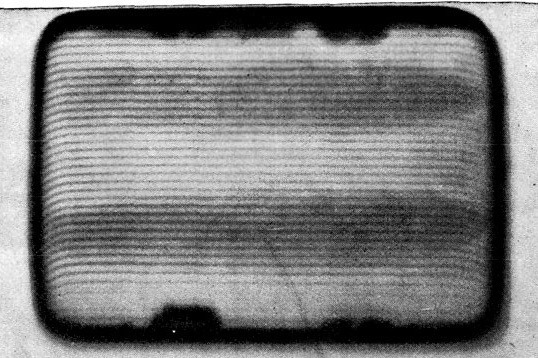
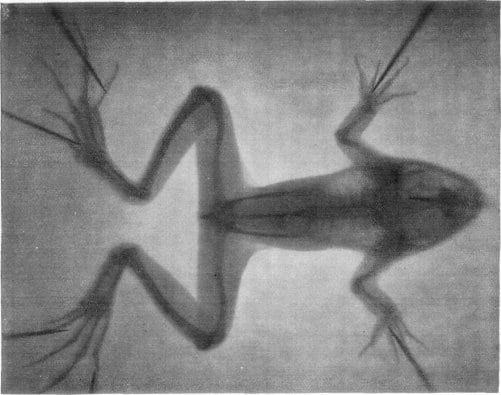
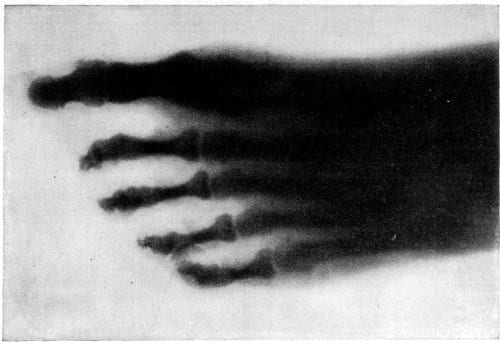
It will be seen that the Röntgen rays and their marvellous practical possibilities are still in their infancy. The first successful modification of the action of the rays so that the varying densities of bodily organs will enable them to be photographed, will bring all such morbid growths as tumors and cancers into the photographic field, to say nothing of vital organs which may be abnormally developed or degenerate
How much this means to medical and surgical practice it requires little imagination to conceive. Diagnosis, long a painfully uncertain science, has received an unexpected and wonderful assistant; and how greatly the world will benefit thereby, how much pain will be saved, and how many lives saved, the future can only determine. In science a new door has been opened where none was known to exist, and a side-light on phenomena has appeared, of which the results may prove as penetrating and astonishing as the Röntgen rays themselves.
The most agreeable feature of the discovery is the opportunity it gives for other hands to help; and the work of these hands will add many new words to the dictionaries, many new facts to science, and, in the years long ahead of us, fill many more volumes than there are paragraphs in this brief and imperfect account.
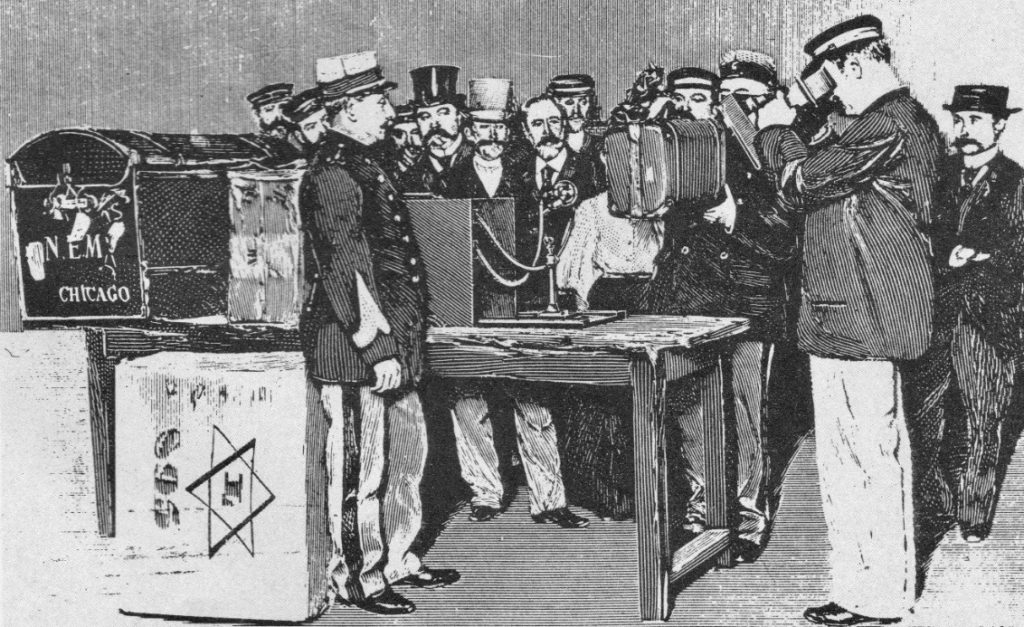
References
- Lenard P. Ueber Kathodenstrahlen in Gasen von atmosphärischem Druck und im äussersten Vacuum. Annalen der Physik. 1894; 287(2): 225–267
- Röntgen WC. Ueber eine neue Art von Strahlen. In: Sitzungsberichten der Würzburger Physikalischen-Medicinischen Gesellschaft 1895 [English translation: On a New Kind of Rays. Nature 1896; 53: 274–276]
- Dam HJW. The new marvel in photography. a visit to professor rontgen at his laboratory in Würzburg – His own account of his great discovery. Interesting experiments with the cathode rays. Practical uses of the new photography. McClure’s magazine 1896 April; VI(5): 403-415
- Barker GF. Röntgen rays: memoirs by Röntgen, Stokes, and Thomson. Translated and Edited by George F. Barker. 1898
- Wilhelm Conrad Röntgen (1845 – 1923)
- Peh WCG, History of the discovery of X rays, Part II- Controversies surrounding and following Röntgen’s discovery. Singapore Med J 1995; Vol 36: 554-558
- Patton DD. Chapter II: Röntgen and the discovery. In: A history of the Radiological sciences.
- Etter LE. Some historical data relating to the discovery of the Roentgen rays. The American journal of roentgenology and radium therapy, 1946; 56: 220– 231
eponymictionary
the names behind the name
